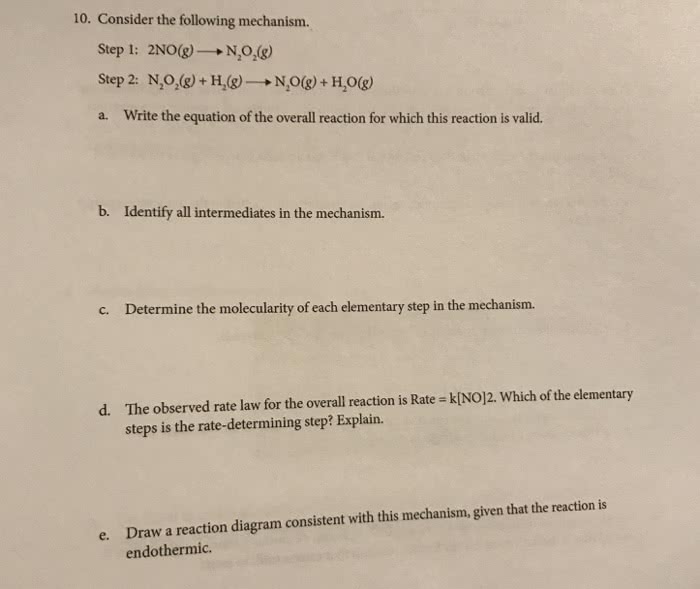Order and rate law of a reaction The overall order of anelementary step directly corresponds to its molecularity. Bothsteps in this example are second order because they are eachbimolecular. Furthermore, the rate law can be determined directlyfrom the number of each type of molecule in an elementary step. Forexample, the rate law for step 1 is rate=k[NO2]2 The exponent "2"is used because the reaction involves two NO2 molecules. The ratelaw for step 2 is rate=k[N2O4]1[CO]1=k[N2O4][CO] because thereaction involves only one molecule of each reactant. Analyzing anew reaction Consider the following elementary steps that make upthe mechanism of a certain reaction: 2A?B+C B+D?E+C
Part A What is the overall reaction? Express your answer as achemical equation.
Part B
Which species is a reaction intermediate?
Part C
What is the rate law for step 1 of this reaction?
Express your answer in standard MasteringChemistry notation. Forexample, if the rate law is k[A][C]3 type k*[A]*[C]^3.
Part D
What is the rate law for step 2 of this reaction?
Express your answer in standard MasteringChemistry notation. Forexample, if the rate law is k[A][C]3 type k*[A]*[C]^3.
Order and rate law of a reaction The overall order of anelementary step directly corresponds to its molecularity. Bothsteps in this example are second order because they are eachbimolecular. Furthermore, the rate law can be determined directlyfrom the number of each type of molecule in an elementary step. Forexample, the rate law for step 1 is rate=k[NO2]2 The exponent "2"is used because the reaction involves two NO2 molecules. The ratelaw for step 2 is rate=k[N2O4]1[CO]1=k[N2O4][CO] because thereaction involves only one molecule of each reactant. Analyzing anew reaction Consider the following elementary steps that make upthe mechanism of a certain reaction: 2A?B+C B+D?E+C
Part A What is the overall reaction? Express your answer as achemical equation.
Part B
Which species is a reaction intermediate?
Part C
What is the rate law for step 1 of this reaction?
Express your answer in standard MasteringChemistry notation. Forexample, if the rate law is k[A][C]3 type k*[A]*[C]^3.
Part D
What is the rate law for step 2 of this reaction?
Express your answer in standard MasteringChemistry notation. Forexample, if the rate law is k[A][C]3 type k*[A]*[C]^3.


